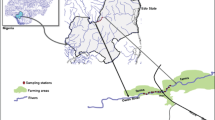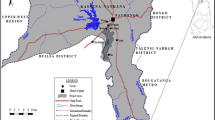Abstract
Production and use of most organochlorine pesticides (OCPs) was banned through the Stockholm Convention on persistent organic pollutants. However, appreciable amounts are still detected in the environment due to their persistence, illegal use, and releases from contaminated soils and obsolete stocks. The present study investigated the levels of OCP residues in Nairobi River. Sediment and water samples were collected from three sites along the river and screened for 17 OCPs using gas chromatography electron capture detector (GC-ECD). Mean pesticide residues ranged from 0.01 to 41.9 μg kg−1 in sediment and below detection limit to 39.7 ng L−1 in water. In sediment α-HCH, β-HCH, γ-HCH, heptachlor epoxide, and p,p′-DDD were detected in all samples, while α-HCH, γ-HCH, δ-HCH, heptachlor epoxide, endosulfan I, and endrin were detected in all water samples. Levels of OCPs in water were below the WHO maximum allowable limits for surface water. However, values higher than the sediment quality guidelines for sediment samples in Racecourse Road Bridge and Outering Road Bridge were reported, thus confirming the toxicity to aquatic organisms. Consequently, as these compounds are known to bio-accumulate in fatty tissues, continued use of the river water poses a health risk to animals and humans.




Similar content being viewed by others
References
Barhoumi B, LeMenach K, Dévier M, El Y, Hammami B, Ameur WB, Hassine SB, Cachot J, Budzinski H, Driss MR (2014) Distribution and ecological risk of polychlorinated biphenyls (PCBs) and organochlorine pesticides (OCPs) in surface sediments from the Bizerte lagoon, Tunisia. Environ Sci Pollut Res 21:6290–6302
Canadian Council of Ministers of the Environment (CCME) (1999) Canadian soil quality guidelines for the protection of environmental and human health. CCME, Winnipeg
Covaci A, Gheorghe A, Voorspoels S, Maervoet J, Steen Redeker E, Blust R, Schepens P (2005) Polybrominated diphenyl ethers, polychlorinated biphenyls and organochlorine pesticides in sediment cores from the Western Scheldt river (Belgium): analytical aspects and depth profiles. Environ Int 31:367–375
Doong R, Lee S, Lee C, Sun Y, Wu S (2008) Characterization and composition of heavy metals and persistent organic pollutants in water and estuarine sediments from Gao-ping River, Taiwan. Mar Pollut Bull 57:846–857
Dulo SO (2008) Determination of some physico-chemical parameters of the Nairobi River, Kenya. J Appl Sci Environ Manag 12(1):57–62
Everaarts JM, Van Weerlee EM, Fischer CV, Hillebrand TJ (1998) Polychlorinated biphenyls and cyclic pesticides in sediments and macro-invertebrates from the coastal zone and continental slope of Kenya. Mar Pollut Bull 36(6):492–500
Floehr T, Xiao H, Scholz-Starke B, Wu L, Hou J, Yin D, Zhang X, Ji R, Yuan X, Ottermanns R, Roß-Nickoll N, Schäffer A, Hollert H (2013) Solution by dilution? A review on the pollution status of the Yangtze River. Environ Sci Pollut Res 20:6934–6971
Getenga ZM, Keng’ara FO, Wandiga SO (2004) Determination of organochlorine pesticides in soil and water from river Nyando Drainage System within Lake Victoria Basin, Kenya. Bull Environ Contam 72(2):335–343
Hiller E, Zemanová L, Sirotiak M, Jurkovič L (2011) Concentrations, distributions, and sources of polychlorinated biphenyls and polycyclic aromatic hydrocarbons in bed sediments of the water reservoirs in Slovakia. Environ Monit Assess 173:883–897
Hong SH, Yim UH, Shim WJ, Oh JR, Lee ES (2003) Horizontal and vertical distribution of PCBs and chlorinated pesticides in sediments from Masan Bay, Korea. Mar Pollut Bull 46:244–253
Karanja N, Mutua KG, Ayuke F, Njenga M, Prain G, Kimenju J (2010) Dynamics of soil nematodes and earthworms in urban vegetable irrigated with wastewater in the Nairobi River basin, Kenya. Trop Subtrop Agroecosyst 12:521–530
Kinyamu JK, Kanja LW, Skaare JU, Maitho TE (1998) Organochlorine pesticides residues in milk of urban mothers in Kenya. Bull Environ Contam Toxicol 60:732–738
Kithiia MS, Wambua NB (2010) Temporal changes of sediment dynamics within the Nairobi River sub-basins between 1998–2006 time scale, Kenya. Land Reclam 42(1):17–22
Kuranchie-Mensah H, Atiemo SM, Palm LN, Blankson-Arthur S, Tutu AO, Fosu P (2012) Determination of organochlorine pesticide residue in sediment and water from the Densu river basin, Ghana. Chemosphere 86:286–292
Lalah JO, Yugi PO, Jumba IO, Wandiga SO (2003) Organochlorine pesticide residues in Tana and Sabaki Rivers in Kenya. Bull Environ Contam Toxicol 71:298–307
Long ER, Bin C, Smith SL, Calder FD (1995) Incidence of adverse biological effects within ranges of chemical concentrations in marine and estuarine sediments. Environ Manag 19(1):81–97
Muniafu M, Otiato E (2010) Solid Waste Management in Nairobi, Kenya. A case for emerging economies. J Lang Technol Enterpreneursh Africa 2(1):1998–1279
Musyoki MA, Suleiman AM, Mbithi NJ, Maingi MJ (2013) Water-borne bacterial pathogens in surface waters of Nairobi River and health implication on communities downstream Athi River. Int J Life Sci Pharma Res 3(1):1–10
Mutune AN, Makobe MA, Abukutsa-Onyango MOO (2014) Heavy metal content of selected African leafy vegetables planted in urban and peri-urban Nairobi, Kenya. Afr J Environ Sci Technol 8(1):66–74
Mwinyihija M (2012) Pollution control and remediation of the tanning effluent. The Open Environmental Pollution & Toxicology Journal 3:55–64
Rizzi J, Taniguchi S, Martins CC (2017) Polychlorinated biphenyls (PCBs) and organochlorine pesticides (OCPs) in sediments from an urban- and industrial-impacted subtropical estuary (Babitonga Bay, Brazil). Mar Pollut Bull 119:390–395. https://doi.org/10.1016/j.marpolbul.2017.03.032
Salem MS, Khaled A, Nemr AE (2013) Assessment of pesticides and polychlorinated biphenyls in sediments of the Egyptian Mediterranean coast. Egypt J Aquat Res 39:141–152
UNEP (2004) Stockholm convention on persistent organic pollutants (POPs). United Nations Environmental Programme: Geneva, Switzerland
Wandiga SO (2001) Use and distribution of organochlorine pesticides. The future in Africa. Pure Appl Chem 73(7):1147–1155
Wandiga SO, Madadi VO (2009) Water quality issues in East Africa. In: Ahuja S (ed) Handbook of water purity and quality. Academic Press Elsevier, London, pp 39–65
Wandiga SO, Yugi PO, Barasa MW, Jumba IO, Lalah JO (2002) The distribution of organochlorine pesticides in marine samples along the Indian Ocean coast of Kenya. Environ Technol 23(11):1235–1246
Wang H, Omosa BI, Keller AA, Li F (2012) Ecosystem protection, integrated management and infrastructure are vital for improving water quality in Africa. Environ Sci Technol 46:4699–4700
Wasswa J, Kiremire BT, Nkedi-Kizza T, Mbabazi J, Ssebugere P (2011) Organochlorine pesticides residues in sediments from the Uganda side of Lake Victoria. Chemosphere 82:130–136
Webster L, Roose P, Bersuder B, Kotterman M, Haarich M, Vorkamp K (2013) Determinations of polychlorinated biphenyls (PCBs) in sediments and biota. ICES Tech Mar Environ 53:1–19
Willet KL, Ulrich RA (1998) Differential toxicity and environmental fates of hexachlorocyclohexane isomers. Environ Sci Technol 32(15):2197–2207
Williams TM, Rees JG, Ferguson A, Herd RA, Kairu KK, Yobe AC (1997) Metals, petroleum hydrocarbons and organochlorines in inshore sediments and waters of Mombasa, Kenya. Mar Pollut Bull 34(7):570–577
World Health Organisation (WHO) (2011) Guidelines for drinking water quality, 4th Edition. Geneva, Switzerland: World Health Organization
Wu WZ, Xu Y, Schramm KW, Kettrup A (1997) A study of sorption, biodegradation and isomerization of HCH in stimulated sediment/water system. Chemosphere 35(9):1887–1894
Zhang Z, Huang J, Yu G, Hong H (2003) Occurrence of PAHs, PCBs and organochlorine pesticides in the Tonghui River of Beijing, China. Environ Pollut 130(2):249–261
Acknowledgements
E.N Ndunda acknowledges the University of Nairobi for funding her studies.
Author information
Authors and Affiliations
Corresponding author
Ethics declarations
Conflict of interest
The authors declare that they have no conflict of interest.
Additional information
Responsible editor: Ester Heath
Rights and permissions
About this article
Cite this article
Ndunda, E.N., Madadi, V.O. & Wandiga, S.O. Organochlorine pesticide residues in sediment and water from Nairobi River, Kenya: levels, distribution, and ecological risk assessment. Environ Sci Pollut Res 25, 34510–34518 (2018). https://doi.org/10.1007/s11356-018-3398-8
Received:
Accepted:
Published:
Issue Date:
DOI: https://doi.org/10.1007/s11356-018-3398-8




